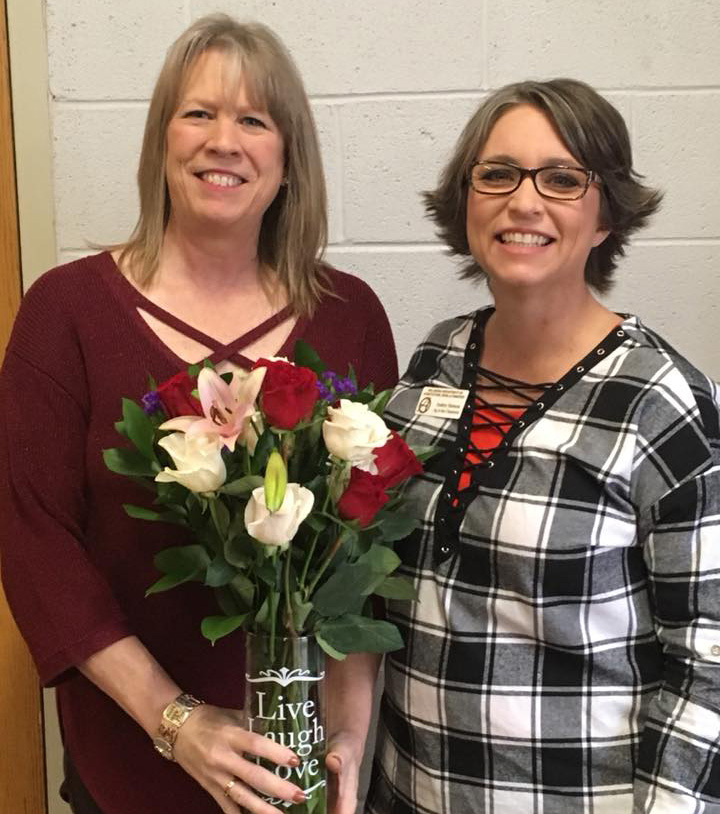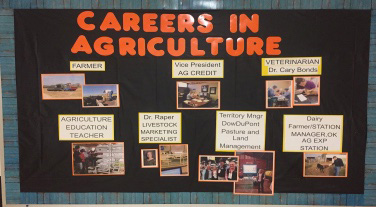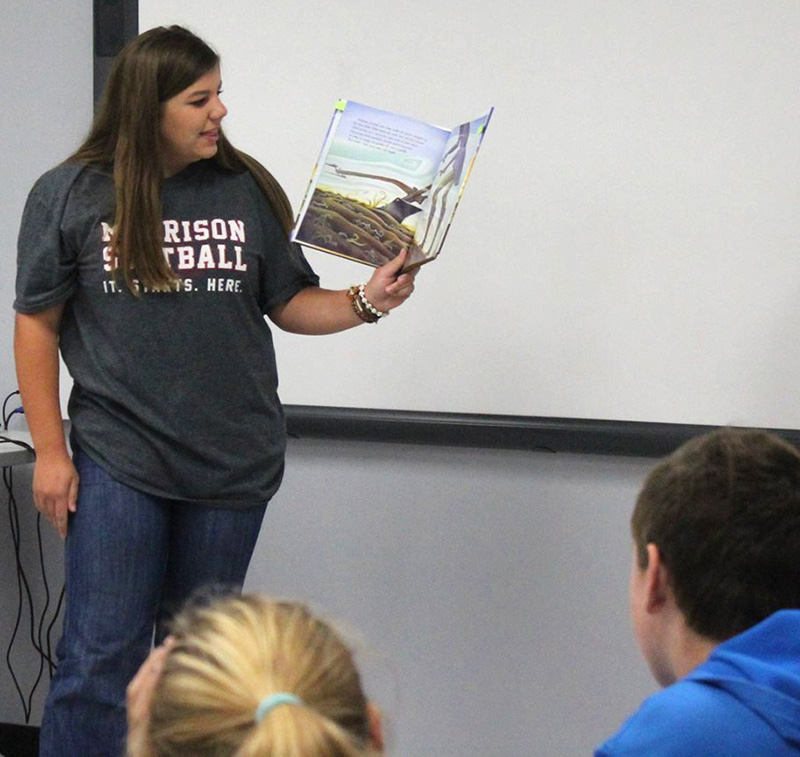Featured Teacher - July
Tammy Will, Morrison
2019 AITC Teacher of the Year, High School Finalist
Q1.
How did you first learn about the Ag in the Classroom Program?
Tammy: I attended my first Ag in the Classroom PD workshop at my school in 2008. In 2015, I traveled on the AITC 3 day bus tour. Since then, I have attended eight other workshops and conferences. I have had the honor of presenting at two AITC State Summer conferences, I attended the National AITC Conference in Maine, and this year I will present at the National AITC Conference in Little Rock, Arkansas.
Q2.
How do you incorporate AITC into your curriculum?
 Tammy: I have always been an advocate of teaching agriculture but in the past six years, I have been more fervent with AITC connections. I have aspirations to educate my students about feeding the world, taking care of the soil, and farming practices that are changing as research provides evidence. It's an opportune time to be in agriculture. We as educators must get students excited about it.
Tammy: I have always been an advocate of teaching agriculture but in the past six years, I have been more fervent with AITC connections. I have aspirations to educate my students about feeding the world, taking care of the soil, and farming practices that are changing as research provides evidence. It's an opportune time to be in agriculture. We as educators must get students excited about it.Agriculture is a way of life for my husband and I. I come alongside him to help as much as I can. As I spend numerous hours in the science classroom, I provide opportunities for my 8th-12th graders to question, wonder, engineer, hypothesize and research in my classroom. My students are more attentive and have a connectedness in their learning.
I see the compatibility between our way of life on the farm and concepts taught to my students. Piloting "Bubbles in Cabbage Juice," which is featured on the AITC website, engages students to question and connect concepts. Another lesson involves building an auger (Archimedes' Screw) where my students discovered issues with the engineering aspect which promoted outside the box thinking.
As my passion grew, I began to introduce different crops. A watermelon was used to produce evidence of a chemical reaction, honey farmers, known as apiculturists, gave presentations to my class and a pumpkin, which is a cucurbit, was utilized in my chemistry class to demonstrate combustible reactions. My students enjoyed this demonstration as it made a boom! Red Cabbage is also a focus in science labs as a pH indicator. Furthermore, my STEM class discusses agricultural uses of drones as they learn to fly.
Q3.
How do you involve the community in your AITC lessons?
Tammy: "Parent involvement in education is like the frosting on a cupcake, it makes it complete and oh so sweet." I am not sure who the author is, but in education, we can all agree! Parent involvement drops as students enter junior high and high school for many different reasons. I began to involve a few parents and community people into my curriculum by inviting them into my classroom over the last few years. For example, I have had two different apiculturists come into my classroom to share their knowledge and demonstrate their passion for raising honey bees. One of the honey farmers was the uncle to my student and the other was a parent. Another time, the Noble County NRCS brough their rainfall trailer to my classes which allowed a hands-on approach to learning about erosion.
To create my "Agriculture Careers" bulletin board, I began by looking at the different careers and looking for a picture representative of those specific careers. One night as I was working at home, I thought to myself, why not incorporate people in our community that my students would know, that hold agriculture jobs! As I began brainstorming and making my list, I found that the people in our community were often times parents of my students. It was fun to hear a high school student point and say, "Is THAT my mom?" As they take a closer look, they realize that it was indeed their mom highlighted on my bulletin board. As it turns out, all my highlighted agriculture careers are parents of current or graduated students or were a past student here at Morrison Public Schools.
 One common misconception is that the only agriculture jobs are farming, truck driving, or becoming an Ag teacher. We utilize the AITC lesson "Helping the Little Red Hen" to talk about careers in agriculture using strategic discussions about research, genetic engineering, agriculture communications, sales representatives, ag credit bankers and many other areas that are connected to agriculture.
One common misconception is that the only agriculture jobs are farming, truck driving, or becoming an Ag teacher. We utilize the AITC lesson "Helping the Little Red Hen" to talk about careers in agriculture using strategic discussions about research, genetic engineering, agriculture communications, sales representatives, ag credit bankers and many other areas that are connected to agriculture.
A new adventure is my Biotech workshop, which was accepted this year at NAITC! Students are exposed to biotech in many industries such as plants, animals, aquaculture, biofuels and food safety, opening their knowledge base of careers. I often counsel students about careers as I enthusiastically share career opportunities with them as they contemplate opportunities for their future. "Want to be an Ag Communications graduate?" I ask students during our career talks. We discussed the opportunities in their Agriculture Education classes such as giving speeches, judging and giving reasons, or being on a parli pro team. Those are excellent opportunities to sharpen skills if they have an interest in a specific job. We also talked about photography in computer class being another opportunity to gain experience for future job skills.
To create my "Agriculture Careers" bulletin board, I began by looking at the different careers and looking for a picture representative of those specific careers. One night as I was working at home, I thought to myself, why not incorporate people in our community that my students would know, that hold agriculture jobs! As I began brainstorming and making my list, I found that the people in our community were often times parents of my students. It was fun to hear a high school student point and say, "Is THAT my mom?" As they take a closer look, they realize that it was indeed their mom highlighted on my bulletin board. As it turns out, all my highlighted agriculture careers are parents of current or graduated students or were a past student here at Morrison Public Schools.
 One common misconception is that the only agriculture jobs are farming, truck driving, or becoming an Ag teacher. We utilize the AITC lesson "Helping the Little Red Hen" to talk about careers in agriculture using strategic discussions about research, genetic engineering, agriculture communications, sales representatives, ag credit bankers and many other areas that are connected to agriculture.
One common misconception is that the only agriculture jobs are farming, truck driving, or becoming an Ag teacher. We utilize the AITC lesson "Helping the Little Red Hen" to talk about careers in agriculture using strategic discussions about research, genetic engineering, agriculture communications, sales representatives, ag credit bankers and many other areas that are connected to agriculture.A new adventure is my Biotech workshop, which was accepted this year at NAITC! Students are exposed to biotech in many industries such as plants, animals, aquaculture, biofuels and food safety, opening their knowledge base of careers. I often counsel students about careers as I enthusiastically share career opportunities with them as they contemplate opportunities for their future. "Want to be an Ag Communications graduate?" I ask students during our career talks. We discussed the opportunities in their Agriculture Education classes such as giving speeches, judging and giving reasons, or being on a parli pro team. Those are excellent opportunities to sharpen skills if they have an interest in a specific job. We also talked about photography in computer class being another opportunity to gain experience for future job skills.
Q4.
What impact has AITC had on your classroom?
 Tammy: I have always taken an interdisciplinary approach when teaching science. One example is when I use the red cabbage indicator in Chemistry. I have my students extract the indicator and then use it to perform pH tests on unknown solutions in chemistry. I also connect this lesson to English by having them research red cabbage as an indicator and write an annotated bibliography over the resources that they used in their research. I believe the more a student learns to extract information through researching, the more successful that student will be in their future as a college student or in their future job. I discuss the assignment with my English coworker that teaches my chemistry students so that she is aware they will be working on their annotated bibliography. She supports their questions in her class as well. I enjoy working with my English teacher to show the relationship between subjects.
Tammy: I have always taken an interdisciplinary approach when teaching science. One example is when I use the red cabbage indicator in Chemistry. I have my students extract the indicator and then use it to perform pH tests on unknown solutions in chemistry. I also connect this lesson to English by having them research red cabbage as an indicator and write an annotated bibliography over the resources that they used in their research. I believe the more a student learns to extract information through researching, the more successful that student will be in their future as a college student or in their future job. I discuss the assignment with my English coworker that teaches my chemistry students so that she is aware they will be working on their annotated bibliography. She supports their questions in her class as well. I enjoy working with my English teacher to show the relationship between subjects.Another assignment I use cross curriculum in English is when I have my students write a poem over a science topic during their poetry lessons in English. We collaborate and use the assignment for a grade in both subjects.
Another way in which I teach cross curricular is by having my students participate in contests with AITC, as well as, the Conservation District contests. Both entities hold contests in art, essays, or newspaper publishing which teaches my students to formulate their research into writing or some kind of project. My students need to know the importance of writing as it pertains to reporting on their research. My students also have participated in the art contests. This is definitely using a different side of their brain! When developing a picture, they can relate the science in agriculture to art. We have a whole class discussion and brainstorming session of ideas that can be used on their poster or their essay. We make whole class lists to prompt their creative juices which helps them construct an outline of their project.
Q5.
How have the AITC lessons impacted your students lives?
Tammy: The pumpkins and watermelons that I use for my science experiments, attract all kinds of questions from my students. The questions prompt an opening into a discussion that I grew the pumpkins at home and that my co-worker grew the watermelons. I could demonstrate the same reactions with another science apparatus, but it peaks the curiosity of the students when they see the crops. Choosing an interdisciplinary approach to teaching in my science class provides for a meaningful, engaging style of learning that promotes greater acquisition of skills!
Flying a drone is fun but being able to build your own drone is an amazing opportunity that my students have in my STEM class. My first two classes learned the skill to fly and we connected the uses of drones in agriculture. We discussed using drones to check cattle, checking diseases, spraying weeds and drought in crop fields. I took my STEM classes to our farm and we practiced our piloting skills and they maneuvered the drones over our cattle. In addition, my current students spend time performing maintenance tasks using their engineering skills.
Flying a drone is fun but being able to build your own drone is an amazing opportunity that my students have in my STEM class. My first two classes learned the skill to fly and we connected the uses of drones in agriculture. We discussed using drones to check cattle, checking diseases, spraying weeds and drought in crop fields. I took my STEM classes to our farm and we practiced our piloting skills and they maneuvered the drones over our cattle. In addition, my current students spend time performing maintenance tasks using their engineering skills.
Q6.
How do you fund your AITC lessons?
Tammy: This year, I was able to set up my Aquaponics display with the assistance of students, I was afforded this opportunity from a Pork Council Grant. This will allow opportunities for furthering the concept of a symbiotic cultivation of plants and aquatic animals in a recirculating environment.
Another endeavor where I was afforded the cost of new Biotech equipment came through a grant. The purpose was to engage students by teaching them to use the equipment to research agriculture topics. I incorporated my love for agriculture by encouraging student research in an agriculture field. One student completed a DNA analysis on soy foods to determine whether or not the food was made with GMO products. Her learning grew exponentially as she did her research on GMO's.
Currently, my projects include buying equipment, which will be purchased with my Pork Council Grant, so my students can produce 360º videos about farming practices. Partnering with AITC, these videos will be featured on the AITC website.
In addition, I teach Soybean Workshops across Oklahoma to educate teachers. One of my goals I am currently working on is to design an agriculture lesson that incorporates 3D printing. Bringing this technology into my class has exposed my students to new and exciting things. By printing a plant cell, students can use their tactile senses to help connect the organelles in a plant cell. Printing a 3D molecular structure allows my students to touch what has previously been a 2D written molecule!
Another endeavor where I was afforded the cost of new Biotech equipment came through a grant. The purpose was to engage students by teaching them to use the equipment to research agriculture topics. I incorporated my love for agriculture by encouraging student research in an agriculture field. One student completed a DNA analysis on soy foods to determine whether or not the food was made with GMO products. Her learning grew exponentially as she did her research on GMO's.
Currently, my projects include buying equipment, which will be purchased with my Pork Council Grant, so my students can produce 360º videos about farming practices. Partnering with AITC, these videos will be featured on the AITC website.
In addition, I teach Soybean Workshops across Oklahoma to educate teachers. One of my goals I am currently working on is to design an agriculture lesson that incorporates 3D printing. Bringing this technology into my class has exposed my students to new and exciting things. By printing a plant cell, students can use their tactile senses to help connect the organelles in a plant cell. Printing a 3D molecular structure allows my students to touch what has previously been a 2D written molecule!
Q7.
What final thoughts do you have for other teachers about the AITC curriculum?
Tammy: My day flows with the coming and going of different ages of students. I often capitalize on teachable moments within my curriculum. In my rural school, I find that many of my students have misconceptions about agriculture. It's our way of life at home and it has become my passion to expose my students to factual and engaging curriculum. After all, they are our future in agriculture. We have heard that by the year 2050, we will need to be able to feed 9.2 billion people on our earth. This statistic alone ignites an urgency within me to educate students. My passion, as an educator and farmer's wife, is that our students understand where their food comes from, how the food is grown and harvested and how careers are involved in this process!
